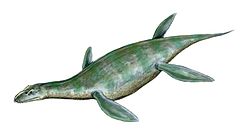Umoonasaurus
Appearance
| Umoonasaurus Temporal range: Early Cretaceous,
| |
|---|---|

| |
| Umoonasaurus demoscyllus from the Early Cretaceous of Australia | |
| Scientific classification | |
| Kingdom: | |
| Phylum: | |
| Class: | |
| Order: | |
| Suborder: | |
| Family: | |
| Genus: | Umoonasaurus
|
| Species: | U. demoscyllus
|
| Binomial name | |
| Umoonasaurus demoscyllus Kear, Schroeder & Lee, 2006 [2]
| |
Umoonasaurus is an extinct genus of plesiosaur[1] belonging to the family Leptocleididae.[3] This genus lived approximately 115 million years ago (Aptian-Albian) in shallow seas covering parts of what is now Australia. It was a relatively small animal around 2.5 m (8 ft) long. An identifying trait of Umoonasaurus is three crest-ridges on its skull.[2]
Umoonasaurus is known from a relatively complete skeleton preserved as opal from Coober Pedy in South Australia. This specimen was prepared by Paul Willis at the Australian Museum, Sydney, and became the focus of a nationwide fundraising appeal coordinated by ABC TV's Quantum program.[citation needed]
See also
References
- ^ a b Ketchum, H. F., and Benson, R. B. J. (2010). "Global interrelationships of Plesiosauria (Reptilia, Sauropterygia) and the pivotal role of taxon sampling in determining the outcome of phylogenetic analyses". Biological Reviews. 85: 361–392. doi:10.1111/j.1469-185X.2009.00107.x. PMID 20002391.
{{cite journal}}: CS1 maint: multiple names: authors list (link) - ^ a b Kear BP, Schroeder NI, Lee MSY. 2006. An archaic crested plesiosaur in opal from the Lower Cretaceous high-latitude deposits of Australia. Biology Letters 2: 615–619.
- ^ Smith AS, Dyke GJ. 2008. The skull of the giant predatory pliosaur Rhomaleosaurus cramptoni: implications for plesiosaur phylogenetics. Naturwissenschaften e-published 2008.
External links
- http://www.livescience.com/animalworld/060707_aquatic_reptile.html
- http://www.journals.royalsoc.ac.uk/media/public/contributionsupplementalmaterials/8/3/n/1/83n10t6p17011132/archive1.pdf







